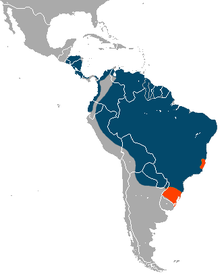
Back Myrmecophaga tridactyla AN آكل النمل العملاق Arabic آكل النمل الكبير ARZ Preyxol (Myrmecophaga tridactyla) AVK Böyük qarışqayeyən Azerbaijani Гіганцкі мурашкаед Byelorussian Голям мравояд Bulgarian Merienaer meur Breton Veliki mravojed BS Os formiguer Catalan
| Giant anteater[1] Temporal range: Montehermosan–Recent
~ | |
|---|---|

| |
| A specimen at Copenhagen Zoo, Denmark, 2005 | |
| Scientific classification | |
| Domain: | Eukaryota |
| Kingdom: | Animalia |
| Phylum: | Chordata |
| Class: | Mammalia |
| Order: | Pilosa |
| Family: | Myrmecophagidae |
| Genus: | Myrmecophaga Linnaeus, 1758[4] |
| Species: | M. tridactyla
|
| Binomial name | |
| Myrmecophaga tridactyla | |

| |
| Range
extant
possibly extinct
| |
| Synonyms | |
| |
The giant anteater (Myrmecophaga tridactyla) is an insectivorous mammal native to Central and South America. It is one of four living species of anteaters, of which it is the largest member. The only extant member of the genus Myrmecophaga, it is classified with sloths in the order Pilosa. This species is mostly terrestrial, in contrast to other living anteaters and sloths, which are arboreal or semiarboreal. The giant anteater is 182 to 217 cm (5 ft 11+1⁄2 in to 7 ft 1+1⁄2 in) in length, with weights of 33 to 50 kg (73 to 110 lb) for males and 27 to 47 kg (60 to 104 lb) for females. It is recognizable by its elongated snout, bushy tail, long fore claws, and distinctively colored pelage.
The giant anteater is found in multiple habitats, including grassland and rainforest. It forages in open areas and rests in more forested habitats. It feeds primarily on ants and termites, using its fore claws to dig them up and its long, sticky tongue to collect them. Though giant anteaters live in overlapping home ranges, they are mostly solitary except during mother-offspring relationships, aggressive interactions between males, and when mating. Mother anteaters carry their offspring on their backs until weaning them.
The giant anteater is listed as vulnerable by the International Union for Conservation of Nature. It has been extirpated from many parts of its former range. Threats to its survival include habitat destruction, fire, and poaching for fur and bushmeat, although some anteaters inhabit protected areas. With its distinctive appearance and habits, the anteater has been featured in pre-Columbian myths and folktales, as well as modern popular culture.
- ^ Gardner, A. L. (2005). "Order Pilosa". In Wilson, D. E.; Reeder, D. M. (eds.). Mammal Species of the World: A Taxonomic and Geographic Reference (3rd ed.). Johns Hopkins University Press. p. 102. ISBN 978-0-8018-8221-0. OCLC 62265494.
- ^ Miranda, F.; Bertassoni, A.; Abba, A. M. (2014). "Myrmecophaga tridactyla". IUCN Red List of Threatened Species. 2014: e.T14224A47441961. doi:10.2305/IUCN.UK.2014-1.RLTS.T14224A47441961.en. Retrieved 19 November 2021.
- ^ "Appendices | CITES". cites.org. Archived from the original on 5 December 2017. Retrieved 14 January 2022.
- ^ Linnæus, Carl (1758). Systema naturæ per regna tria naturæ, secundum classes, ordines, genera, species, cum characteribus, differentiis, synonyms, locis. Tomus I (in Latin) (10th ed.). Holmiæ: Laurentius Salvius. p. 35. Archived from the original on 8 November 2012. Retrieved 23 November 2012.
- ^ Smith, P. (2007). Giant anteater Myrmecophaga tridactyla Linnaeus, 1758 FAUNA Paraguay. pp. 1–18. Archived from the original on 25 October 2022. Retrieved 7 March 2019.
{{cite book}}:|work=ignored (help)
© MMXXIII Rich X Search. We shall prevail. All rights reserved. Rich X Search
